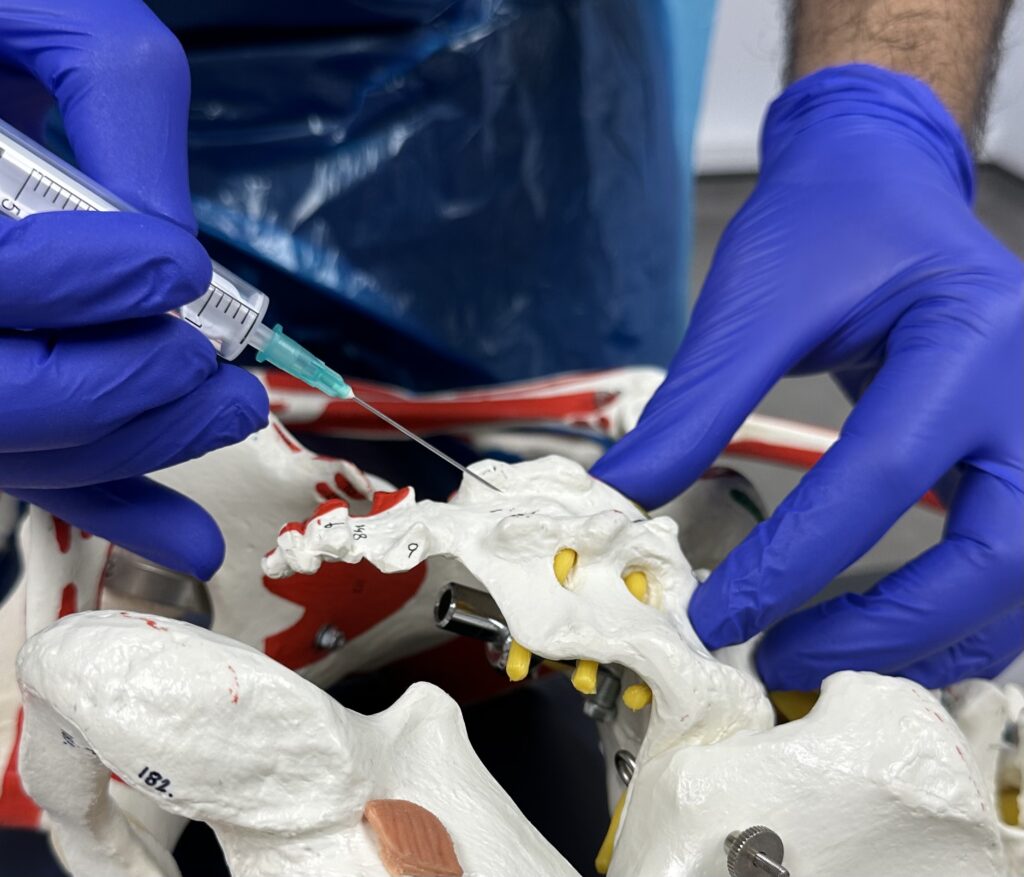A Caudal epidural injection is a spinal injection used to manage low back and leg pain such as that experience during episodes of Sciatica.
It frequently involves injecting a mixture of local anaesthetic and steroid into the epidural space of the spine to reduce inflammation and pain.
This method is often recommended for conditions such as Sciatica, Disc herniation, Degenerative Disc Disease or Spinal Stenosis.
Patients considering this treatment often have questions about what the procedure involves.
The procedure is usually performed as an outpatient treatment, meaning patients can go home the same day. It is important to understand the potential side effects and risks involved.
Anatomy and Mechanism of Action
The Epidural Space lies inside the spine and contains the spinal cord and nerves. The injection is administered through a small opening at the base of the spine, known as the Sacral Hiatus.
Here, the medication spreads upwards and around the irritated nerves (nerves which are ‘irritated’ from a disc herniation’.
Local anaesthetic provides immediate pain relief by numbing the area, while the steroid helps to further reduce inflammation over the following 1-2 weeks
Doctors can use fluoroscopy or ultrasound to perform these injections.
This ensures that the medication is delivered with precision.
Indications and Benefits
This procedure is used to reduce inflammation and provide pain relief effectively. Most patients experience significant pain relief and minimal downtime after the procedure, making it a preferred choice for managing lower back pain secondary to Disc herniation, Sciatica or Spinal Stenosis.
Conditions Treated
Back Pain
Sciatica
Spinal Stenosis
- Lumbar Disc Herniation
Caudal Epidural Injections are primarily used to treat back pain and leg pain linked to irritated or inflamed nerves.
They are especially helpful for individuals suffering from Sciatica, which causes pain to radiate down the legs.
This injection can also treat back and leg pain from spinal stenosis, a condition where the spinal canal narrows and compresses the nerves.
In conditions related to a herniated disc, where the disc impinges on nearby nerves, the injection helps decrease inflammation and pain. .
These treatments are typically considered when other conservative methods, such as physical therapy and medications, have not provided sufficient relief.
Caudal Epidural: Expected Outcomes
After receiving a Caudal epidural injection, most patients can expect significant pain relief.
The medication in the injection reduce inflammation around the nerves, leading to decreased pain in the lower back and legs, including the areas affected by Sciatica.
In our experience, this injection is helpful in reducing pain in 75-80% of the patients who are deemed suitable to have it.
Patients usually notice improvement within a few days, although it may take longer for some (up to 7-14 days).
The treatment is an outpatient procedure, allowing patients to go home the same day.
Relief duration can vary, with some experiencing benefits for several months.
This procedure can help patients return to daily activities with less discomfort, improving their overall quality of life.
Pre-procedure Preparation
It is essential to prepare correctly for a Caudal Epidural injection to ensure success and safety of the procedure.
Key elements in the preparation process include Consultation, examination and obtaining consent, alongside clear instructions about medications.
Initial Consultation
During the initial consultation, patients will meet with the Doctor to discuss their medical history and current health status. This includes a review of their medical history and any medications they are taking.
The patient is carefully examined to see if a Caudal Epidural will help and medications and any medical conditions are reviewed to see if it is safe.
The Procedure of Caudal Epidural Injection
Technique Overview
A Caudal Epidural injection involves administering the medication at the base of the spine near the sacral hiatus. The patient usually lies in a prone position (face down) for better access to the injection site.
The clinician first cleans and sterilises the area to be injected.
A needle is then carefully inserted into the sacral hiatus to numb the region. This frequently contains local anaesthetic.
The sacral hiatus is an opening in the sacral bone. Once the needle is correctly positioned, the doctor injects the medication, sometimes mixed with a local anaesthetic, into the Epidural Space.
Ultrasound Guidance
Ultrasound guidance is often used to increase the accuracy of the procedure. The ultrasound provides real-time images of the spine and surrounding tissues. This helps the doctor guide the needle accurately to the targeted area.
Besides ultrasound, Fluoroscopy (an x-ray technique) is also commonly used.
Fluoroscopy allows continuous x-ray imaging, which helps the doctor confirm the correct placement of the needle.
This imaging reduces the risk of complications and improves the effectiveness of the injection as a contrast medium/dye is injected.
Post-Procedural Care
After a Caudal Epidural injection, patients must follow specific care instructions to ensure recovery and manage any discomfort.
Immediate aftercare is crucial, and long-term management focuses on continued relief and well-being.
Immediate Aftercare
Typically, the patient remains in our clinic for 30 minutes. They should avoid driving for the rest of the day and arrange for someone to take them home if possible.
Common side effects post injection may include temporary numbness or weakness in the legs, dizziness, or mild pain at the injection site.
Ice packs can help reduce swelling and ease discomfort. It is important to inform the medical team if there are unusual symptoms like severe pain, fever, or difficulty urinating.
Long-term Management
For long-term care, patients should follow up with their Doctor to assess the effectiveness of the Epidural Injection. Pain management often includes a combination of medication, such as anti-inflammatory drugs, and physical therapies.
Physiotherapy may be recommended to strengthen the back muscles and improve mobility.
Patients should avoid strenuous activities for a few days following the injection but can gradually return to normal activities as advised by their doctor.
They might also receive guidance on proper posture and exercises to prevent further back issues. Regular follow-up appointments help ensure ongoing relief and address any recurring pain or discomfort.
Potential Complications and Management
Caudal Epidural injections can sometimes lead to complications such as infection or bleeding. Nerve Damage should not occur as the injection is performed at the sacral base away from the nerves
Recognising these issues early and knowing how to manage them are crucial to ensure patient safety and effective treatment.
Recognising Complications
One of the primary risks of Caudal Epidural injections is infection.
It is important to watch for symptoms like fever, swelling, or redness at the injection site. These could indicate an infection that needs prompt medical attention. Less commonly, there may be signs of a severe infection, including confusion or a significant drop in blood pressure.
Improving Treatment Outcomes
Optimal treatment outcomes following Caudal epidural injections rely on the Doctor and Patient education. Paying attention to these factors can lead to better pain management and improved quality of life for patients.
Patient Education and Lifestyle
Patient education is crucial for the success of Caudal Epidural injections. Patients should be informed about the procedure, potential benefits, and possible side effects. Understanding what to expect can reduce anxiety and improve cooperation during the treatment process.
Lifestyle changes complement medical treatments in managing chronic pain. Patients are encouraged to engage in physical rehabilitation and avoid activities that may exacerbate pain.
This can enhance the effectiveness of Caudal Epidural injections. .
Developments in Epidural Injections
Significant progress has been made recently in the administration and efficacy of Caudal Epidural injections. Researchers have examined the effectiveness of different mixtures, such as combining normal saline with lidocaine and triamcinolone acetate.
There have also been studies which have cited non Cortisone Epidurals to work for Chronic low back pain secondary to Disc pathology. These are something we have adopted in our clinic also. These studies aim to optimise pain relief for conditions like chronic low back pain and radicular pain.
In addition, there have been comparisons of different techniques in administering these injections. The Caudal approach is highlighted for its use in targeting the epidural space through the sacral hiatus. This method continues to show promise for treating lumbar spinal stenosis effectively.
Ongoing research also focuses on long-term outcomes. Studies have observed positive results in patients with post-surgical low back pain, indicating significant improvement in many cases.
This suggests that these injections could be beneficial for managing chronic conditions related to spinal issues.
We often also perform Caudal Epidurals in patients failed back surgery syndrome, where it can offer pain relief where other measures have failed.
Conclusion
Caudal Epidural injections are a common method used to treat low back pain, lumbar disc herniations, spinal stenosis and sciatica.
Research indicates their effectiveness, with many patients experiencing significant pain relief and reduced need for surgery.
There is evidence that Caudal Epidural injections can manage painful conditions related to the lumbosacral spine.
These injections are generally considered safe with low complication rates.
Advantages include:
Reduced need for surgical intervention
Effective in alleviating sciatica symptoms
- Lower technical difficulty compared to other procedures
Limitations:
May not be as effective for treating certain types of back pain
- Success rates can vary between patients
In conclusion, Caudal Epidural injections offer a viable treatment option for many patients, providing significant benefits.
Frequently Asked Questions
This section covers important aspects of Caudal Epidural injections, including potential side effects, UK costs, recovery expectations, duration of effects, and mobility post-injection.
What are the potential side effects of a Caudal Epidural injection?
Caudal epidural injections can have some side effects. Common ones include headaches, temporary numbness, and soreness at the injection site. More serious side effects are rare but may include infection or bleeding. It is crucial to discuss these risks with your healthcare provider. Cortisone itself can cause flushing or menstrual disturbances in women
How much does a Caudal Epidural injection typically cost in the UK?
In the UK, the cost of a Caudal Epidural injection can vary. Private treatment may range between £1000 to £2500 per injection. Costs may also depend on the specific clinic and any additional services provided.
Some injections may be covered by the NHS, reducing personal expenses significantly.
What should one expect during the recovery period following a Caudal Epidural injection?
After a Caudal Epidural injection, patients typically rest for a short period before returning home.
Mild discomfort or soreness at the injection site is common. Normal activities can usually be resumed within 24-48 hours, but strenuous activity should be avoided for a few days. Follow-up appointments might be required to evaluate the effectiveness and address any concerns.
How long are the effects of a Caudal Epidural injection expected to last?
The duration of relief from a Caudal Epidural injection can vary. Some patients experience pain relief for several weeks, while others may have relief lasting several months (6-12). Factors such as the underlying condition and the individual’s response to the treatment influence the duration of effects.
Is it possible to walk immediately after receiving a caudal epidural injection?
Yes, most patients can walk immediately after receiving a Caudal Epidural injection. However, it is advised to rest for a short while before resuming normal activities. Driving or operating heavy machinery should be avoided for at least 24 hours post-injection to ensure safety.
Where can I Get a Caudal Epidural Injection?
At MyMSK Clinic we initially proceed with a detailed examination of the patient. This involves a physical examination.
Once the patient and Doctor is certain of the diagnosis and the procedure is considered safe, they may wish to proceed with a Caudal Epidural. This can be done in the same session.
A Caudal Epidural can be done at both our clinics in Burnley and Manchester. A Caudal Epidural may range from £300-£350 depending on the Clinic location.
If you would like to arrange a consultation please visit our online Booking Page or call us on 0333 772 965





